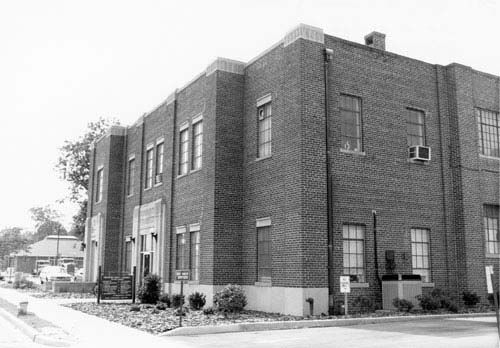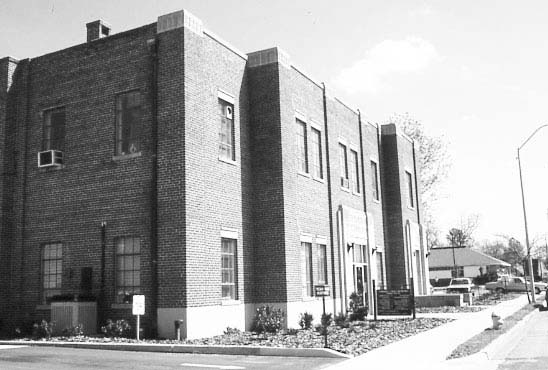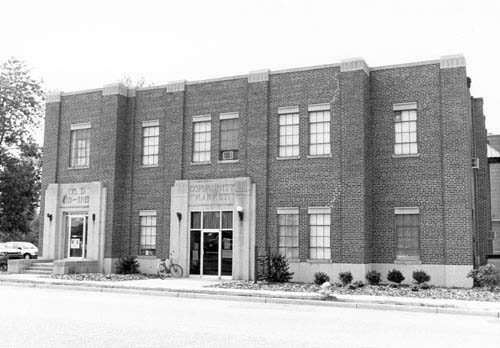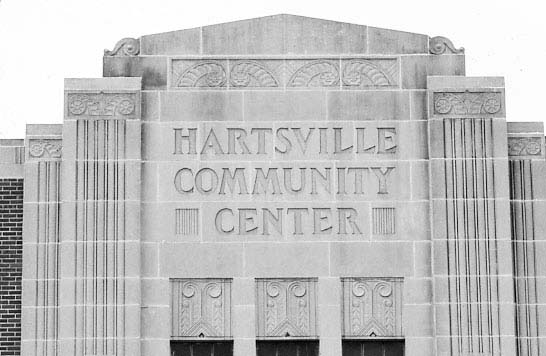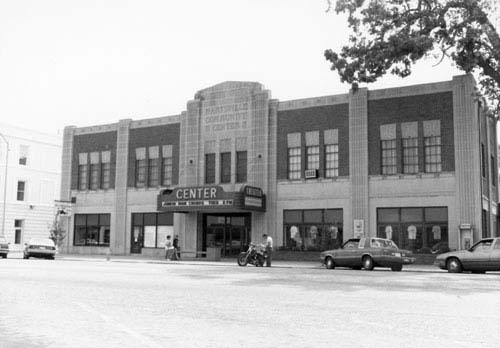History of Center Theater
Center Theater is housed in the beautiful Hartsville Community Center Building on Fifth Street. The building was a dream of the Hartsville community during The Great Depression of the early 1930s.
The Community Center Building, also known as "Building A," was one of three built on the block as part of the same project. The project also included the Hartsville Post Office, also on Fifth Street, which is now used as the Hartsville Museum. Third, the Hartsville Community Market building was built just behind the Community Center on College Avenue and now hosts the Black Creeks Arts Council.
The Hartsville Community Center is a two-story, rectangular plan building with a flat roof and parapet. The building is clad with running bond, red brick and decorative cast-stone trim. The five bay symmetrical façade features reeded pilasters with stylized capitals and a central entry bay. The entry bay has cast-stone cladding, pilasters, a pedimented parapet with stylized motifs, and a streamline marquee. The Community Market is a two-story, rectangular plan building with a flat roof and parapet. The building has a common bond, red brick cladding and cast stone trim. Three stepped planes invigorate the five bay asymmetrical façade. The façade features brick pilasters with stylized cast-stone capitals. The building has a central primary entrance set within a cast-stone surround.
Much of the project was funded by the Public Works Administration through federal loans as part of the New Deal era public projects in South Carolina. The striking art deco facades were designed by architects Lafaye & Lafaye of Columbia. Wheatley & Mobley of Augusta, Georgia, constructed the buildings.
On July 15, 1935, a ceremony was help to celebrate the laying of the cornerstone for the Hartsville Community Center Building, the first building to begin construction. Inside the cornerstone was placed a sealed copper box holding a copy of the first town charter, a list of local men who died in WWI, a 30-page scrapbook of photos of early Hartsville scenes, and written histories of Hartsville. At the ceremony, A. L. M. Wiggins, chairman of the Building Commission, said,
“Coming at a time when the country was trying to pull out of the depression, this progressive program of Hartsville was a great boost to the morale of the community.”
The community center building originally held a moving-picture theater, the Hartsville Chamber of Commerce, a conference room and offices for rent, offices of the City and public works, the Hartsville Library. Tenants in the rented offices included a law office, a soda shop, and an office supply store.
The beautiful theater now holds 867 seats and is fully equipped with modern lighting and sound systems. All three buildings were listed in the National Register on June 4, 1997. Read the nomination form for inclusion into the registry.
The Hartsville Building Commission has remained a governing board since 1934 and serves to preserve the three historic buildings for the community.
Center Theater has hosted several famous artists, including Loretta Lynn (twice), Johnny Cash, The Three Stooges, and the Von Trapp Family. More recently, the theater has welcomed Edwin McCain, the Columbia Ballet's The Nutcracker Ballet, and the sold-out community fundraiser Dancing with The Stars of Darlington Country.
###
Wilmont Berry recalls the Theatres in Hartsville, SC
Hartsville, SC - March 30, 2005
When we moved here to Hartsville I think they were still showing movies at the old Temple Theater. The Temple Theater was built as an auditorium and meeting place. Pretty soon they put a screen up on the stage and started showing movies. Teenage boys would sit in the balcony. They bought bags of peanuts to throw at the rats. Of course, that’s just what the rats wanted.
After the theater closed there was a vegetable market just inside. The rest of the theater was getting pretty dilapidated. Pigeons got in there and the roof was about to cave in. When I was the building official for the City I asked the man who bought the three buildings that included the theater to do something with it. It was right in the middle of town. It was where the Centennial Park is now. It faced 5th Street.
I met him there one day and we went inside. He said he thought the building was sound. We got about half way into the theater when the floor gave way and he fell through. All that was sticking up above the floor was his head. He said, “Yeah. I reckon we ought to tear it down.”
The Center Theater was built in 1935 with WPA labor. It was built for performing arts. It had a flyloft. The town had to pay part of the cost. So, they set up a township and these people that lived about five miles around Hartsville paid a little bit of tax. That was paid off in 1967, I believe. When they built it they had some footlights but no lighting as we know it today. They had no dressing rooms.
Just before the Second World War we had some people here who wanted to do some live theater. They got started but then the war came along and stopped it. All during the war years and up until we came here in 1959, it was a movie theater. There was a screen up on the stage about six feet behind the main drape. During that time the seats were slashed. There was gum on the floor. It was pretty torn up.
W. W. Tisdale, he’s a good old fellow, I think the world of him. He was the choral leader at school. Each spring he would put on a play. I got started early on helping him with them. I had a float building company in Saluda and we brought that here with us. For that reason, he asked me to help him build scenery and rigging for the lights. We did “Oklahoma” and Mr. Tisdale did all the music on a portable organ.
About 1965, the theater was a mess, and the mayor and some other people got interested in restoring the theater for live performances. During that time, the man who presented the movies in there built the Berry Theater. The community raised $200,000 and we put dressing rooms in the back, stage rigging, and lighting. We built a thrust stage to cover the orchestra pit when it was needed. The drape that is hanging in there now is the original drape that was placed in there in 1935.
We had a restored theater but nobody to use it. So, I called a few people that might be interested and asked them to meet me at the theater. They were interested and so we decided to have a community-wide meeting. We advertised the meeting and a bunch of people showed up. We set up a steering committee and got things underway. I was president of it for about ten years.
We did Don’t Drink the Water. I remember it so well. It was a nice little play and it was successful. Today the Hartsville Community Players are still going strong. The young woman who is directing the upcoming play was there from the beginning. She took part in everything we did.
This is all in that book I wrote about Hartsville, Scraps of History: Hartsville, S.C., 1950-2003.
This story has been reproduced, with permission, from SC Movie Theatres.
Wilmont Berry’s Scraps of History: Hartsville, S.C., 1950-2003 was published by R.L. Bryan Company in 2004 and is 298 pages long. Scraps of History can be purchased at the Hartsville Museum and local bookstores.
Sources:
SC Movie Theatres


